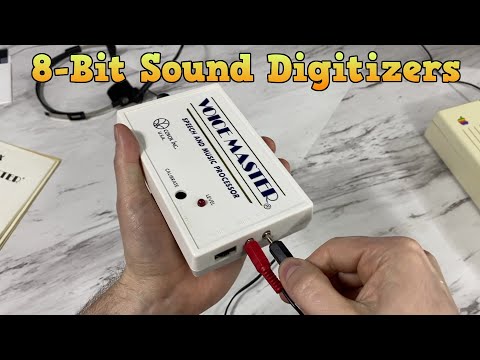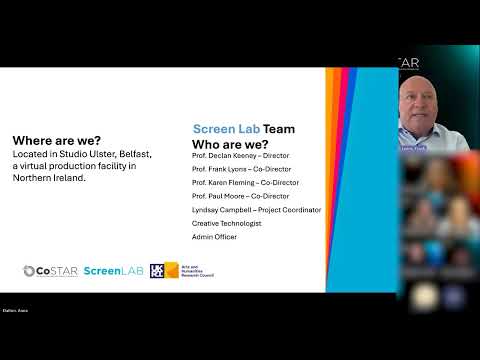Early 8-Bit Sound Digitizers

In the early 1980s, we were shocked and amazed by games that included recorded speech. Another Visitor. Stay a while. Stay forever! Ghostbusters. Keep in mind that computers from that time period did not have audio inputs. That didn’t really become commonplace until the 1990s.
So, today we’re going to have a look at a few products that came out in the mid 1980s that allowed you to sample sounds from the real world into your computer. One of those is the sound samples made by Commodore. And another one is the Covox voice master.
And I have two versions here. This one is the Commodore 64 version, and I also have an Apple II version. We’re going to take a look at all 3 of these. So, the Sound Sampler is the first product we’re going to try out. This came out in 1985. And this is a UK version that was donated to me a while back.
Let’s open it up and have a look inside. We get a thin manual, and the software comes on cassette. Which makes since because in that time most everyone in the UK was still using cassettes. However, I went online and found the software on disk, and created my own as that will be more convenient for me.
Here’s the actual cartridge. It has an input volume and a feedback control. On the side it has two RCA jacks for input and output. And of course it plugs into the cartridge port of the Commodore 64. And it has a pass through port so you can leave this cartridge connected while still being able to use other cartridges. It comes with a little microphone.
And since it doesn’t have the correct connector on the end, they’ve included a little converter for you. As you can see, the ports are labelled on the bottom. So this would go here. And then they’ve given you this.
And don’t feel bad if you are puzzled as to what this is. This actually plugs into the monitor port on your C64. I’ll explain that in a little bit. If you think this cartridge looks familiar, it’s probably because it highly resembles the sound expander, which gives FM synthesis to your C64, and of course the Commodore magic voice cartridge, which is a speech synthesizer. These all share a common case design.
And all have to do with sound as well. So, what we’ll do is plug this in here. And the Audio output connects to the monitor output.
Now the reason for this is that there is actually an audio input on that same jack. Of course, you can’t record from that, it’s just a passthrough. But since most people back in the day would be using the RF connection like this to their television, which carries both audio and video in the same cable, this was a convenient way to mix the audio with the C64’s built in sound. Of course, in my case, I’m using a real monitor, so I need that port open.
So what I’ll do is just plug a sound cable in here, and run that to the back of my monitor. I’ll unplug the C64 audio temporarily. That just means I won’t be able to hear anything from the SID chip, but that’s okay, we won’t be using it for this example. OK, I’m ready to power it on, and of course, load up the software.
So, this software is menu driven, which to be honest was not common in 1985. But notice that they want you to use the function keys for cursor keys. That’s probably because they knew the average consumer would be confused by Commodore’s weird cursor keys. Anyway, so let’s record our first voice sample. I’ll need to check the input volume by watching the meter on the screen.
Testing, testing, 1, 2, 3. Testing. Testing. Testing. Testing. Testing.
Testing. Testing. Testing.
OK, so let’s record something. Hey Techmoan, what do you think of this audio format? Once the sound is recorded, there are a number of things you can do, such as examine the waveforms, etc. To play back, it’s actually designed to use the incredible musical keyboard attachment. However, my bread bin C64 isn’t working right now, so all I have is the 64C. Trouble is, the musical keyboard doesn’t fit the 64C. So I’ll just make due without it.
Techmoan, what do you think of this audio format? Techmoan, what do you think of this audio format? Techmoan, what do you think of this audio format? Techmoan, what do you think of this audio format? So, let’s record something more interesting. Yeah! Yeah! Yeah! Yeah! Yeah! Yeah! Yeah! Yeah! Yeah! Yeah! Yeah! Let’s hear this backwards. You can also define a section of the waveform to use as an infinite loop.
So in this regard it works kind of like an old Casio SK series sampling keyboard. OK, so let’s try out the echo feature. I’m going to set it to .1 seconds.
Hey listen to this, it’s like an echo. Like social media. Let’s try a little bit longer.
OK. Here’s another test. Ok, wow.
It sounds like something from science fiction. And I figure you’ll want to see what’s on the inside of this thing. Now, despite being a cartridge, it has no actual ROM chips. It looks like the heart of this product is the analog digital converter, right here. OK, let’s have a look at the Covox Voice Master. Now, this particular product was actually sold for several different computers including the Commodore, Apple II, and Atari.
This box, however, does not actually say anywhere on it which platform that it’s marketed for. Now, I happen to know this is the Commodore 64 version. It is possible that when it was shrink-wrapped that it had a sticker or something on it that said Commodore. But the box itself simply does not say. I have actually never played with one of these before.
But I remember seeing it in the Commodore Buyers Guide that I must have read through a hundred times when I was a kid. So I was always fascinated by the device. It’s nice having the original boxes for these things so we can see exactly how it was packaged. There are actually 3 or 4 different manuals included, that deal with the various programs that come on the disk. Speaking of, here it is.
Interesting that they printed these labels what a dot-matrix printer. Anyway, here we go. This version of the software came out in November of 1987.
And one interesting thins is how white this product is. I mean, if you compare to my Apple II version, there is quite a contrast. Speaking of, you might actually be asking what the difference is between these since the look identical. Well, the main difference is the cable end. The Apple IIc version is male and the Commodore version is female.
In fact, you could actually connect these together if you wanted. Not that it does any good. However, the insides are completely different.
I don’t honestly know if this difference is down to Commodore vs. Apple implementation or maybe one board is an earlier revision than the other. Anyway, back to the unboxing. It comes with this very 80s looking microphone headset. Yeah, this is a very 1980s style headset.
I haven’t worn anything like this in quite some time. Yeah, there we go. This is kind of flimsy here. Yeah, very 1980s! You also get a couple of other cables. These are passthrough cables which will take the audio from the computer and pass it through to your headset speaker.
But these are optional as you can just listen to the audio through the speaker in your TV or monitor. And here’s something odd in the bottom of the box. “Genuine Covox Adjust Tool”. This looks like somebody just cut the handle of of a fork or something.
I’m not sure if this is a joke from the previous owner, or if this really came from the factory. Anyway, the idea is there is a little potentiometer recessed in the box and this tool fits in there and can turn it. Anyway, let’s connect this thing up. The microphone is red, the speaker is black. This part plugs into joystick port 2.
And we’ll need the disk. Upon starting the software, you get this menu. As you can see there are a number of activities you can do with your VoiceMaster. First thing I’ll do is calibrate mine. And sure enough, step #3 actually references the “official Covox adjustment tool” so I guess that’s really a thing! So let’s do a little test here. I’m going to push F1.
This is a test of the Covox Voice Master, 1, 2, 3. OK, now we’re going to push F3 to play it back. This is a test of the Covox Voice Master, 1, 2, 3.
OK, definitely not the best audio quality I’ve heard. SO, now I want to show you something crazy. So apparently the software is not smart enough to stop the recording when it runs out of memory.
So, watch this. OK, I’m just going to keep on talking here until the computer runs out of memory. Now, you’d think the program would be smart enough to stop itself but unfortunately it’s not.
I’m just going to keep talking here and eventually. Come on. There we go. The computer just crashes. I’ve seen it crash in a number of different ways.
Somebody didn’t think this through too well. OK, so here’s the spectrum display. So, Well, works pretty much like you’d expect. It does, sort of. At least it measures the amplitude pretty well. Not so sure on the actual spectrum.
OK, so what about speech recognition. It has a demo program here. First you do have to train it to your speech. Covox. Voicemaster.
Computer. Finish. OK, so the idea is, it’s supposed to recognize when I say one of those words. Voicemaster.
Computer. Finish. So, yeah, that actually works decently well considering the era of technology that we’re talking about here. OK, so there’s also a game of blackjack that you can play.
Now, playing blackjack on a computer is nothing new, but what this program does is it allows you to play it more or less by voice command only. Ok, here we go. Cards.
Cards. 1. 3. Bet. 9 of hearts. 8 of hearts.
Jack of clubs. Hit me. 5 of spades.
I win. Menu. OK, so it sort of, kind of works. It would be an awful way to actually play this game. Now we’re going to try the hum-along program. Also known as the voice-harp.
So what this program is supposed to do is allow you to hum or whistle into the microphone and it will find the frequency and play that as a regular computerized tone on the Sid-chip. But, the question is, how well does it work? OK. So unfortunately the sound from the monitor actually gets picked up by the headset and it’s kind of like this, you know, infinite loop. So I’ve got the volume turned down on the monitor right now and I’m going to turn it up hopefully just enough that you can hear both me and the computer. So, the problem is Is there’s a bit of a delay between the time I make the sound and and the time the computer responds. And it’s extremely disorienting if you’re trying to sing.
Not only that, but I’m not really a good singer. I can’t really sing on key, so let’s try somebody that can. OK, my daughter has agreed to sing for me, and what I’m going to do is record the sound from the computer directly into the Zoom recorder. That way we won’t hear it during the recording.
And then we can see how closely it resembles what she sings. It goes like this, the fourth, the fifth The minor falls, the major lifts The baffled king composing Hallelujah OK, so I’m going to have to say that the voice harp is pretty useless. I think it’s more or less just a gimmick.
And I don’t think anybody could do anything particularly useful with it. So, let’s move on and play around with the composer. Now this software is supposed to allow you to hum or whistle a tune, and it will translate that into musical score.
At the menu here, we’ll select record. One problem I noticed right away is that it doesn’t take tempo into account very well. I mean, it sort of does. But it’s just not really working properly. You’ll see what I’m talking about.
So we’re going to play back what I just recorded. Actually, I don’t even think most of those notes and even if they were, the tempo being totally just totally screws it up. But again, let’s try it with somebody who has a little bit better voice than me. You make me happy when skies are gray. You’ll never know dear, how much I love you, please don’t take my sunshine away. OK, since that didn’t work all that well, let’s try cheating by using something that has perfect pitch.
That was a C major scale. So, most of these notes are correct, but it identified the wrong octave for most of them. And thus when you play it back, it sounds nonsensical. I think is safe to say the musical capabilities of the Covox are pretty useless. The software also includes some other speech related programs, but these don’t actually require the Covox hardware to work.
For example, there is a talking clock program. The time is 3:24 PM. There’s also a talking calculate program that works in English or Spanish. 4 2 times 2 3 equals 9 6 6. So I was curious how this thing worked and wanted to tone out which pins on the joystick port it actually connects to. I was somewhat surprised at what I discovered.
So, I pretty much figured it would connect to 5V and ground. And it does. No surprise there.
But I was curious if it used the digital I/O pins of the joystick, or the analog inputs of the paddles. Well, it turns out it connects to both. The only pin it doesn’t use is the joystick button on pin 6. So I wrote a little program in basic to monitor the data on the various registers that data would be coming in over, but unfortunately, I never saw any change on any of these when talking into it. So I’m obviously missing something.
Oh well. Ok, time to try out the Apple Iic version. It plugs into the special joystick port on the Apple IIc.
Although it might work on the IIgs which has the same connector. Anyway, let’s give it a shot. By the way, finding the software for this was tough. Thankfully somebody on the Apple II Facebook group uploaded a copy for me, so here it is.
I’ll use the same headset from the Commodore version as its the only one I have. So, it appears it is loading a version that is customized for the Apple Iic. And we get the same little intro voice as on the Commodore version.
COVOX PRESENTS VOICE MASTER And the menu looks pretty similar to the one on the Commodore. Most of the same features. Let’s try making a recording OK So this is a test of the Apple Iic version. OK let’s play that back. OK So this is a test of the Apple Iic version.
Well, here’s the little spectrum analyzer again. Very similar to the Commodore version, only there’s no color. So there’s no voice-harp on the Apple II for obvious reasons, it has no dedicated sound chip. But it does have the composer. So I’m going to do the same test here with the keyboard. And, I think it works about as crappy as the Commodore version.
Let’s play that back. Yeah, well. I did notice there was a demo file on the disk called Vivaldi. Presumably somebody at Covox made this, let’s give it a try. Ummm.. I have no comment on that.
The apple II has a bit different speech recognition program. This is just a proof of concept. It runs in 80 columns mode.
This program doesn’t actually do anything other than let you test menu options. File. Attribute. Edit. Paragraph. Fix.
Resolution. OK, that works pretty well. The Apple IIc version also has the same clock and calculator programs.
But, now I’m kind of curious if this will run on a Laser 128, since it does have that same joystick port that the Iic has. One thing it does differently is it asks if I have a sound-master. Keep in mind that is a different product from the voice-master. Anyway, we don’t so I will say no.
And this is interesting, it has actually detected that it is running on a Laser 128. So the folks at Covox actually took the Laser into account when designing this. Anyway, I’ll do a quick test to see if it really works. Testing on the Laser 128. Testing on the Laser 128.
Well, I guess it works! OK, so unfortunately, these products are maybe a little bit disappointing to me as far as what they’re able to do. Some of the things they do pretty well, like speech recognition, which was never really fully utilized. But the actual sampling quality was pretty poor and the sampling length was pretty poor. Of course that was mostly due to the limitation of RAM on these computers. Nevertheless, when I had my Commodore 64 as a kid, I would have probably loved to play with this. Just, you know, as a toy.
I would have probably spent hours playing around with it, so it would have had some entertainment value. That being said, I want to tell you a funny story. I had an Amiga 500 when I was maybe 16-17. And I got a sound sampler for it. I don’t even remember which one it was, but it plugged into the parallel port.
And one of the things I noticed it could do, it could record pretty long samples, because you know, the Amiga had a lot more RAM and the samples were much more high fidelity than what you’ve seen on these products. And one of the things I noticed is that it had the ability to reverse audio. So, there was this episode of Doctor Who that came out in the seventies but you know, I had seen it recently on a rerun. And the Doctor was talking to the Master through the Tardis system and he had to speak backwards. And Jo was very perplexed by this.
And so I got the idea to take the VHS tape I had of that and pull it into my Amiga 500 and then reverse it so that I could hear what he was saying. Unfortunately, I was pretty disappointed as it turns out he was quite literally just saying gibberish. I thought maybe they had reversed the clip for the audio, maybe he was really saying something, but he wasn’t. But not too long after that, this episode of Red Dwarf came out called “Backwards” And it was kind of the same thing, there were a lot of things in this episode where people were talking backwards and doing things backwards. So I recorded several of these clips and I was not disappointed when I played that one backwards.
Take a listen. I’m addressing the one prat in the country who’s going to get hold of this recording, turn it around and actually work out the rubbish that I’m saying. So yeah, I think it aired in the UK first, and then in the USA later. So I was probably one of the first people in the USA to actually hear what the guy was really saying. So I felt pretty proud of myself and I was really surprised at the message that they left there.
Anyway, I guess this wraps it up for the sound samplers. There’s actually quite a few more of these out there and as I get them, I might do another video follow up later showing some different sound samplers. But that’s all for this one, so thanks for watching!
2022-01-23 13:43


